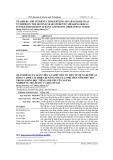
88 Vo Thi My Linh, Nguyen Thi Quynh Hoa
A STUDY OF “ATTITUDE” IN ENGLISH RESTAURANT REVIEWS FROM
THE PERSPECTIVE OF APPRAISAL THEORY
Vo Thi My Linh1*, Nguyen Thi Quynh Hoa2
1Master Student in English Linguistics, The University of Danang - University of Foreign Language Studies, Vietnam
2The University of Danang - University of Foreign Language Studies, Vietnam
*Corresponding author: vtmylinh1997@gmail.com
(Received: October 12, 2024; Revised: November 26, 2024; Accepted: November 27, 2024)
DOI: 10.31130/ud-jst.2024.438E
Abstract - Appraisal Theory is a framework developed by James
Martin and Peter White in the 1990s which was based on the
theoretical model of systemic functional linguistics. The appraisal
system in this theory is a functional model that functions at the
discourse semantic level, with a focusing on interpersonal
meaning. The purpose of this paper aims to find out the language
of “Affect”, “Judgement” and “Appreciation” in the category
“Attitude” used in English restaurant reviews in terms of syntactic
features and semantic features. The findings reveal that the
semantic features, the positive evaluative Attitudes reflected in
the samples outweigh the negative values. In terms of the
syntactic features, Adjective Groups and Nominal Groups are
more frequently used than Verbal Groups, Adverbial Groups and
Prepositional Phrases. On the basis of the finding, the article
provides basic knowledge about the evaluative discourse and to
some extent enables them to interpret a discourse.
Key words - Affect; Judgement; Appreciation; semantic features;
syntactic features
1. Rationale
Understanding the expression “Attitude” in English
restaurant reviews is critical in today’s competitive
culinary market. These reviews play an important
communication channel between customers and
businesses, which allows people to share their preferences,
rates, and experiences with food and service. A well-
written review not only improves consumer decisions but
also influences restaurant reputations. Furthermore, the
linguistic features used in these reviews have an important
function in influencing perceptions and can increase the
persuasive power of feedback. According to Martin and
White [1] the effective use of language evaluative
circumstances allows people to successfully communicate
their feelings (Affect), assess the quality of services and
behaviors (Judgement), and evaluate the cuisine and
overall dining experience (Appreciation).
Being aware of the importance of “Attitude” in English
restaurant reviews is essential for understanding consumer
behavior and enhancing the effectiveness of feedback
mechanisms in the restaurant industry. In the light of
Appraisal Theory, this article explores how linguistic
features such as Affect, Judgement and Appreciation are
reflected in the syntactic features and semantic features of
English restaurant reviews, providing deeper insights into
evaluative language and its implications.
From these bases, this study seeks to answer two research
questions: (1) What are the syntactic features of Affect,
Judgement and Appreciation in English restaurant
reviews? (2) What are the semantic features of the above-
mentioned sub-categories of “Attitude” in English
restaurant reviews?
2. Theoretical background
2.1. Appraisal Theory by Martin and White (2005)
2.1.1. Appraisal Theory
Appraisal Theory, developed by Martin and White [1]
is a framework within the broader field of Systemic
Functional Linguistics (SFL) that focuses on how language
is used to express evaluation, stance, and emotion in
discourse. According to Martin and White [1, p.1],
Appraisal theory emphasizes the interpersonal function of
language, highlighting how writers and speakers project
their subjective perspectives in discourse by taking stances
toward both the topic they present and the audience with
whom they communicate. Furthermore, this theory is
concerned with “evaluation - the kinds of Attitudes that are
negotiated in a text, the strength of the feelings involved
and how values are sourced and readers aligned” [2].
Angela Downing and Philip Locke [3] take a
functional approach to English grammar, basing their
analysis on the works of Halliday [4]. This viewpoint
emphasizes that grammar is not just a set of rules but a
tool for effective communication, allowing learners to
understand how different structures serve specific
purposes in language use.
This study is mainly concerned with an investigation
into “Affect”, “Judgement” and “Appreciation” in English
restaurant reviews in terms of their syntactic features by
Downing and Locke’s view [3] and semantic features in the
light of Appraisal Theory by Martin and White [1].
2.1.2. The sub-categories of “Attitude”
According to Martin and White [1, p.35], Attitude is
one of three sub-systems of Appraisal Theory which refers
to “our feelings, including emotional reactions”.
Attitudinal meanings can be divided into three
subtypes [1]:
“Affect”: the characterization of phenomena by
reference to emotion.
“Judgement”: the evaluation of human behavior
concerning social norms.
“Appreciation”: the evaluation of objects and products
(rather than human behavior) by reference to aesthetic
principles and other systems of social value.

ISSN 1859-1531 - THE UNIVERSITY OF DANANG - JOURNAL OF SCIENCE AND TECHNOLOGY, VOL. 22, NO. 12, 2024 89
2.1.3. Restaurant
Restaurants play a significant role in our lifestyles and
dining out is a popular social activity. Today, more meals
than ever are being eaten away from home. As a result,
reviews can significantly impact a restaurant’s reputation,
affecting everything from customer footfall to menu
adjustments. The author discusses how feedback from
customers, whether positive or negative, can guide owners
in refining their offerings and enhancing the overall dining
experience [5].
2.2. Previous researches related to the study
Numerous studies have been undertaken across
different subfields, applying Appraisal Theory to examine
evaluative language in diverse contexts. However, few
studies have systematically analyzed the sub-categories of
Attitude namely “Affect”, “Judgement” and
“Appreciation” in English restaurant reviews. The
application of Appraisal Theory, particularly its syntactic
and semantic features has not been thoroughly
investigated. This study provides a detailed analysis of how
Attitude categories are realized in English restaurant
reviews, focusing on their syntactic and semantic features.
It offers both theoretical contributions to Appraisal Theory
and practical implications for the restaurant industry.
3. Research Methods
3.1. Research Design
The qualitative approach is used in describing and
analyzing the data to find out the distinctive realizations of
“Affect”, “Judgement” and “Appreciation” in terms of
syntactic features and semantic features in English
restaurant reviews. On the contrary, the quantitative
produce is useful for determining occurrence frequencies
of “Affect”, “Judgement” and “Appreciation” in
percentage.
3.2. Research Methods
The researchers employed descriptive analysis
techniques to identify specific linguistic features and
realizations of “Affect”, “Judgement” and “Appreciation”
in the collected restaurant reviews. Additionally, the study
focused on the frequency of these categories to further
understand their prevalence in English restaurant reviews.
3.3. Data Collection
Based on the investigation of English Restaurant
Review websites, 5 websites were found active namely:
TripAdvisor, Fine Dining Explorer, Zomato, The
Infatuation, and Great British Chefs. The locations of the
restaurants being reviewed on these websites include larger
cities across English-speaking regions and worldwide.
Among these platforms, two provide restaurant reviews
generated by professional reviewers, while the other three
feature reviews from consumers.
Each website provides numerous reviews that discuss
the customer’s dining experience. However, for the
purposes of this study, only those reviews containing
instances of “Affect”, “Judgement” and “Appreciation”
were selected for analysis. This selective approach
ensures that the data collected is closely related to the
research subject.
With such criteria, 400 samples are chosen from the
most popular restaurant review websites. Finally, such
collected data are taken into researching and analyzing in
order to find out the linguistic features in terms of syntactic
features and semantic features.
3.4. Research Instrument
The tools for identifying and collecting data of the
study were observation and documentary review. Along
with this technique, the Sketch Engine tool was used to
investigate occurrence frequencies of word types such as
Nouns, Verbs, Adjectives, and adverbs in the three aspects
of “Attitude” in syntactic and semantic features.
4. Findings and Discussion
4.1. Syntactic Features of “Attitude” sub-categories
According to Martin and White [1], the development of
Appraisal Theory within the Systemic Functional
Linguistics (SFL) model enables the identification of
“Affect”, “Judgement” and “Appreciation” markers in a
variety of syntactic features such as Verbal Groups,
Nominal Groups, Adverbial Groups, and Prepositional
Phrases.
4.1.1. Syntactic Features of “Affect”
a. “Affect” Features by means of Nominal Groups
Nominal Groups constructed as one of the prominent
structures of “Affect” are complex Nominal Groups
consisting of Head nouns, Pre-modifiers and Post-
modifiers. For example:
(4.1) A deep satisfaction with the exquisite dishes [6].
(4.2) My profound appreciation for the chef’s
creativity was evident throughout the meal, leaving me
hopeful for the future of Gourmet Haven [6].
Table 1. “Affect” in the structure of Nominal Groups
Structural Elements
Determiner
Pre-modifier
Head Noun
Post – modifier
(4.1)
A
deep
satisfaction
with…
(4.2)
My
profound
appreciation
for…
The framework comprising Determiner, Pre-modifier,
Head Noun and Post-modifier is used to analyze these
reviews. Determiners are often possessive adjectives such
as “my” or the article “a” are frequently used to relate to
personal experiences. Pre-modifiers like “deep”,
connected the Determiners. Head Nouns “satisfaction”
and “appreciation” express positive Affect. The post-
modifiers expanding the information of Head nouns are
Prepositional Phrases and That - clauses.
b. “Affect” Features by means of Verbal Groups
Verbal groups which consist of a main verb and its
auxiliaries or modifiers, often play a significant role in
expressing the reviewer’s feelings.
(4.3) We enjoyed the element of surprise and were not
disappointed by the food [6].
(4.4) A very well-executed soufflé but I would have
preferred more bitterness [7].

90 Vo Thi My Linh, Nguyen Thi Quynh Hoa
Table 2. “Affect” in the structure of Verbal Groups
Structural Elements
Subject
Auxiliary
Main Verb
Noun Phrase
(4.3)
I
enjoyed
the element...
(4.4)
I
would have
preferred
more bitterness
As can be seen in Table 2, analyzing these Verbal
Groups the examples (4.3) and (4.4) “enjoyed”, and
“preferred” helps us understand customer’s emotions and
satisfaction levels.
c. “Affect” Features by means of Adjectival Groups
The structure of Adjective Groups in English restaurant
reviews is Adverb, Head Adjective and Prepositional
Phrase. The Head of an Adjective Group is always realized
by an adjective, which may function alone in the
representation of a whole Adjective Group.
(4.5) All were above expectations, but we were really
impressed with the desserts [6].
(4.6) If you need a place to rest up over a cup of coffee,
check this place out. I'm deeply glad to enjoy pastel
Vasco [6].
Table 3. “Affect” in the structure of Adjectival Groups
Structural Elements
Adverb
Head Adjective
Prepositional Phrase
(4.5)
really
impressed
with …
(4.6)
deeply
glad
to enjoy …
d. “Affect” Features of Adverbial Groups
Among the “Affect” resources in the data, there are no
cases where emotions are denoted by Adverbial Groups in
“Affect” realizations in English restaurant reviews.
e. “Affect” Features by means of Prepositional Phrases
(4.7) I have to confess to having many years of
experiencing Michelin 3-star quality in Europe behind
me [8].
Table 4. “Affect” in the structure of Prepositional Phrases
Structural Elements
Head Noun
Adjective Phrase
Prepositional Phrases
(4.7)
I
have to confess
to having…
Table 4 shows the structure determined by Nouns,
Adjectives and Prepositional Phrases as a complement.
4.1.2. Syntactic Features of “Judgement”
“Judgement” is further divided into social esteem and
social sanction covering aspects like normality, capacity,
tenacity, veracity, and propriety.
a. “Judgement” Features by means of Nominal
Groups
Nominal Groups include various components such as
Determiners, Head Noun, Pre –modifiers and Post –
modifiers. Let’s consider the following examples:
(4.8) If you leave Au Cheval disappointed because the
food wasn’t uniformly great, it’s a sign you didn’t go in
with the right expectations [8].
(4.9) His meticulous honesty in the presentation was
impressive [6].
Table 5. “Judgement” in the structure of Nominal Groups
Structural Elements
Determiner
Pre-modifier
Head Noun
Post – modifier
(4.8)
The
right
expectations
(4.9)
His
meticulous
honesty
in the …
From Table 5, Pre-modifier in the structure of Nominal
Groups of “Judgement” are mostly adjectives, linked to the
Determiners are often possessive adjectives or articles,
with the Head Noun word that expresses “Judgement”.
b. “Judgement” Features by means of Verb Groups
It is found that that clause or Noun Phrase can function
as a complement to the verb. Here are some typical
examples:
(4.10) The authenticity of the chicken is still not
convincing that it meets traditional standards, but the rice
certainly was, making the steamed rice the best dish [6].
(4.11) The management demonstrated
professionalism and attention to detail, making the visit to
this restaurant a memorable and enjoyable experience [6].
Table 6. “Judgement” in the structure of Verb Groups
Structural Elements
Noun Phrase
Main Verb
That clause of or
Noun Phrase
(4.10)
The authenticity
of the chicken
is still not
convincing
that it meets
traditional standards
(4.11)
The management
demonstrated
professionalism and
attention to detail…..
c. “Judgement” Features by means of Adjectival
Groups
The typical structure is as follows: Modifier + Head
Adjective + Prepositional Phrase Complement.
(4.12) Whether you are a novice wanting to learn more
about wine or an aficionado seeking to explore new pairings,
they are remarkably adept at guiding customers through an
extensive selection with ease and enthusiasm [6].
Table 7. “Judgement” in the structure of Adjectival Groups
Structural Elements
Adverb
Head
Adjective
Prepositional Phrase
Complement
(4.12)
remarkably
adept
at guiding customers ……
d. “Judgement” Features by means of Adverbial
Groups
The number of Adverbial Groups as “Judgement” is
quite limited in English restaurant reviews.
(4.13) The macarons are ridiculously good and well-
made [6].
Table 8. “Judgement” in the structure of Adverbial Groups
Structural Elements
Subject
Verb
Adverb
Adjective
(4.13)
The macarons
are
ridiculously
good
Adverb “ridiculously” as a “Judgement” marker
modifies the Adjective in (4.13).

ISSN 1859-1531 - THE UNIVERSITY OF DANANG - JOURNAL OF SCIENCE AND TECHNOLOGY, VOL. 22, NO. 12, 2024 91
e. “Judgement” Features via Prepositional Phrases
(4.14) The food was fantastic. The chef was
commended for his innovative dishes [6].
Table 9. “Judgement” Features via Prepositional Phrases
Structural Elements
Noun Phrase
Verb
Prepositional Phrases
(4.14)
The chef
was commended
for his innovative
dishes
4.1.3. Syntactic Features of “Appreciation”
Like “Affect” and “Judgement”, “Appreciation” also
focuses on the syntactic Features shown by types of syntax
groups, namely, Nominal Groups, Verbal Groups,
Adjective Groups, Adverbial Groups and Prepositional
Phrases.
a. “Appreciation” Features by means of Nominal
Groups
(4.15) We took the menu which was an excellent
combination of ingredients and taste [6].
(4.16) Beyond the wine culture, there’s an
extraordinary concentration of Michelin-starred
restaurants in the region [6].
Table 10. “Appreciation” in the structure of Nominal Groups
Structural Elements
Determiner
Pre-modifier
Head Noun
Post -
modifier
(4.15)
an
excellent
combination
of …
(4.16)
an
extraordinary
concentration
of …
Table 10 illustrates that Pre-Modifiers are adjectives
that connect with Determiners and Head Nouns. Post-
modifiers often in the form of prepositional phrases
provide additional details about the Head Noun.
b. “Appreciation” Features by means of Verbal
Groups
(4.17) The feedback from customers has consistently
been valued ensuring a top-notch dining experience [6].
(4.18) The restaurant has repeatedly succeeded in
creating a dining experience that combines great food
with exceptional service [7].
Table 11. “Appreciation” in the structure of Verbal Groups
Structural Elements
Subject
Auxiliary
Head Verb
Gerund Phrase
or Prepositional
Phrases
(4.17)
The feedback
from
customers
has
consistently
been
valued
ensuring a …
(4.18)
The
restaurant
has
repeatedly
succeeded
in creating a
dining …
c. “Appreciation” Features by means of Adjectival
Groups
(4.19) The food was really outstanding that we were
surprised [6].
(4.20) Prices are very reasonable to offer a refreshing
and appreciated experience [6].
Table 12. “Appreciation” in the structure of Adjectival Groups
Structural Elements
Adverb
Head Adjective
That clause, To –infinitive
(4.19)
really
outstanding
that …
(4.20)
very
reasonable
to offer a …
The adjective is modified by the adverb forming a
Modifier + Head Adjective structure. Besides, That clause,
To –infinitive functions as a complement to the adjective.
d. “Appreciation” Features by means of Adverbial
Groups
(4.21) The decor showcased a remarkably elegant
design, adding to the overall charm of the place [6].
Table 13. “Appreciation” in the structure of Adverbial Groups
Structural Elements
Noun Phrase
Verb Phrase
Adverb Phrase
(4.21)
The decor
showcased
remarkably
e. “Appreciation” Features by means of Preposition
Phrases
(4.22) The pasta was cooked with remarkable skill by
the chef [6].
(4.23) The meat was grilled with wonderful flavor. The
waitstaff delivered great service which raised the overall
experience [6].
Table 14. “Appreciation” in the structure of Prepositional Phrases
Structural Elements
Noun Phrase
Verb Phrase
Preposition Phrases
(4.22)
The pasta
was cooked
with remarkable skill
(4.23)
The meat
was grilled
with wonderful flavor
The following figure illustrates the occurrence of
“Affect”, “Judgement” and “Appreciation” in the sample
data and the distribution of syntactic structures in each type.
Figure 1. Occurrence Frequencies of the “Attitude” sub-
categories in terms of Syntactic Realizations
The result of data analysis shows occurrence
frequencies of “Attitude” sub-categories. The result
indicates that “Appreciation” is employed at the highest
frequency (48%), the appearance of “Judgement” takes the
second (30%) and “Affect” is the third (22%).
4.2. Semantic Features of “Attitude” Sub-Categories
This framework expresses emotional responses such as
Un/happiness, In/security, Dis/satisfaction, and
Dis/inclination. By analyzing the semantic features of
Attitude sub-categories, we can observe how both positive
(+) and negative (-) evaluations are expressed, highlighting
the ways in which emotions, judgements, and appreciations
are framed in English restaurant reviews.
48%
22%
30% Appreciation
Affect
Judgement

92 Vo Thi My Linh, Nguyen Thi Quynh Hoa
a. Un/happiness by means of “Affect” Markers
The Un/happiness variable includes emotions related to
which are connected to the mood and feelings, such as
sadness, hate, anger, happiness, and love, etc. [1, p.51]
(4.24) I felt so really happy to spend here (+) [6].
(4.25) The unexpected delight from the appetizers truly
surprised me, but my strong sense of disappointment
with the main course prevented me from being fully
satisfied (-) [6].
b. Dis/satisfaction by means of “Affect” Markers
The dis/satisfaction variable covers emotions
concerned with telos (the pursuit of goals) – ennui,
displeasure, curiosity and respect [1, p.51].
(4.26) A deep sense of satisfaction filled me from the
exquisite dishes, (+) [6].
(4.27) The unexpected delight from the appetizers truly
surprised me, but my strong sense of disappointment with
the main course prevented me from being fully satisfied,
(-) [6].
c. In/security by means of “Affect” Markers
The In/security variable covers emotions concerned
with eco-social well-being- anxiety, fear, confidence and
trust [1, p.51]. Below are some examples:
(4.28) The cleanliness of the place and the
professionalism of the staff gave me a strong sense of
assurance and safety, (+) [7].
(4.29) I'm honestly perplexed by the positive reviews
of this pastry shop, (-) [6].
d. Dis/inclination by means of “Affect” markers
Inclination refers to such feelings as desire or fear. It
denotes how the speaker/writer is inclined or disinclined to
something. [1, p.51]. Below are some examples:
(4.30) I was really craving with Ice cream last night in
San Sebastián and this place did not let us down, (+) [6].
(4.31) We were unenthusiastic about trying the new
vegan dishes at Green Leaf Bistro, (-) [10].
4.2.1. Semantic Features of “Judgement”
a. Social Esteem by means of “Judgement” Markers
“Judgement” of esteem has to do with “normality”
(how unusual someone is), “capacity” (how capable they
are) and “tenacity” (how resolute they are) [1, p.53].
Normality
(4.32) His meticulous honesty in the presentation was
impressive, (+) [6].
(4.33) The noisy atmosphere and haphazard decor
detracted from what should have been a pleasant dining
experience, (-) [6].
Capacity
(4.34) Their exceptional professionalism made our
evening unforgettable, (+) [10].
(4.35) Despite the beautiful setting, the overall
experience was marred by the unprofessional behavior of
the staff, (-) [6].
Tenacity
(4.36) Le Bernardin is a testament to culinary artistry
and ethical cooking, (+) [6].
Veracity
(4.37) The chef’s truthfulness about the origins of each
dish adds to the dining experience. This honesty set the
restaurant apart, (+) [6].
(4.38) The pictures and descriptions online did not
match what was served. This lack of honesty was quite
disappointing, (-) [10].
Propriety
(4.39) The servers were attentive without being
intrusive, and their consideration for our dining
preferences truly elevated the experience, (+) [6].
(4.40) The rude behavior of the staff was unacceptable.
They are disrespectful, (-) [6].
4.2.2. Semantic Features of “Appreciation”
a. Reaction by means of “Appreciation” Markers
Reaction is related to affection (emotive – “it grabs
me”, desiderative – “I want it”). Reaction consists of
Reaction Impact and Reaction Quality [1, p.56]. For
example:
Reaction Impact
(4.41) The presentation of each dish was breathtaking
and truly captivating, (+) [6].
(4.42) The food was visually unappealing, making the
entire meal a disappointment, (-) [6].
Reaction Quality
(4.43) The setting of the restaurant was simply
wonderful, creating a warm and welcoming atmosphere,
(+) [6].
(4.44) The pasta was overcooked and lacked any
distinct flavor, making it an underwhelming dish, (-) [10].
b. Composition by means of “Appreciation”
Markers
Composition is related to perception (our view of
order). It also consists of two small parts: Composition
Balance and Composition Complexity [1, p.56].
Composition Balance
(4.45) The dish was a harmonious blend of flavors,
where each ingredient was in perfect proportion to the
others, (+) [6].
(4.46) The ingredients were not properly aligned,
leading to a disjointed flavor profile that detracted from
the overall dining experience, (-) [6].
Composition Complexity
(4.47) The menu at this restaurant is a testament to
the chef’s ability to create dishes of stunning complexity,
(+) [6].
(4.48) The menu is just made up of decadent versions
of standard diner dishes, with most things priced under
$20, and the burger at center stage, (-) [9].
c. Valuation by means of “Appreciation” Markers



![Tài liệu Từ vựng tiếng Anh Trung cấp [mới nhất]](https://cdn.tailieu.vn/images/document/thumbnail/2025/20250913/nguyentuan250421@gmail.com/135x160/99491757910839.jpg)
![Tài liệu Từ vựng Tiếng Anh theo chủ đề [mới nhất]](https://cdn.tailieu.vn/images/document/thumbnail/2025/20250913/namdhuet@gmail.com/135x160/83251757753810.jpg)



![Tài liệu Từ vựng tiếng Anh cho bé [chuẩn nhất/mới nhất]](https://cdn.tailieu.vn/images/document/thumbnail/2025/20250731/huadaithesang2509@gmail.com/135x160/18631754013896.jpg)








